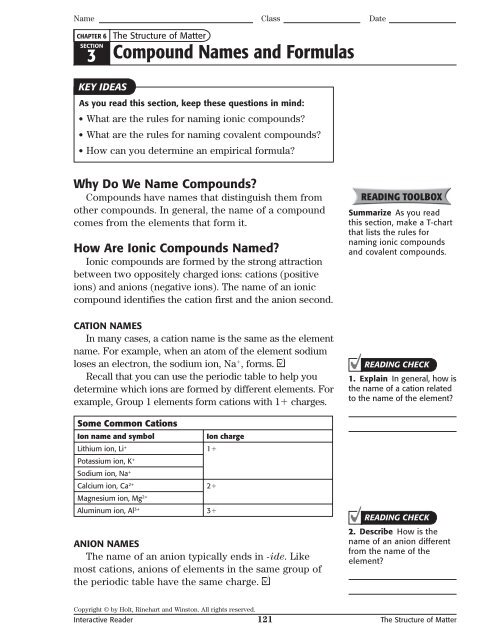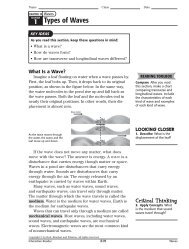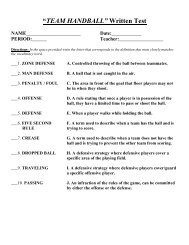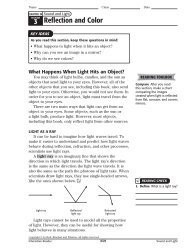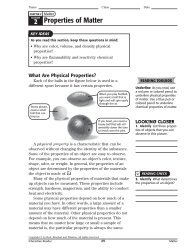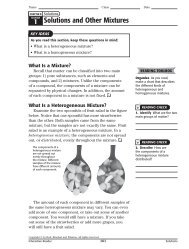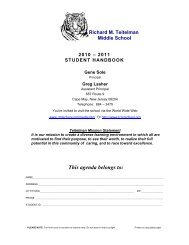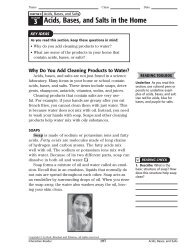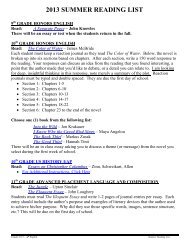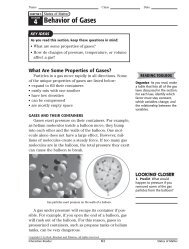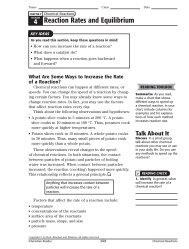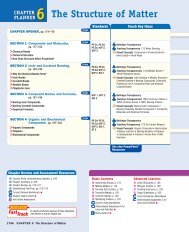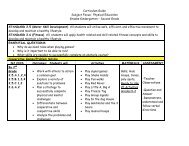3 Compound Names and Formulas
3 Compound Names and Formulas
3 Compound Names and Formulas
- No tags were found...
Create successful ePaper yourself
Turn your PDF publications into a flip-book with our unique Google optimized e-Paper software.
Name Class DateCHAPTER 63 <strong>Compound</strong> <strong>Names</strong> <strong>and</strong> <strong>Formulas</strong>SECTIONThe Structure of MatterKEY IDEASAs you read this section, keep these questions in mind:• What are the rules for naming ionic compounds?• What are the rules for naming covalent compounds?• How can you determine an empirical formula?Why Do We Name <strong>Compound</strong>s?<strong>Compound</strong>s have names that distinguish them fromother compounds. In general, the name of a compoundcomes from the elements that form it.How Are Ionic <strong>Compound</strong>s Named?Ionic compounds are formed by the strong attractionbetween two oppositely charged ions: cations (positiveions) <strong>and</strong> anions (negative ions). The name of an ioniccompound identifies the cation first <strong>and</strong> the anion second.CATION NAMESIn many cases, a cation name is the same as the elementname. For example, when an atom of the element sodiumloses an electron, the sodium ion, Na , forms.Recall that you can use the periodic table to help youdetermine which ions are formed by different elements. Forexample, Group 1 elements form cations with 1 charges.Some Common CationsIon name <strong>and</strong> symbolLithium ion, Li +Potassium ion, K +Sodium ion, Na +Calcium ion, Ca 2+Magnesium ion, Mg 2+Aluminum ion, Al 3+Ion charge1ANION NAMESThe name of an anion typically ends in -ide. Likemost cations, anions of elements in the same group ofthe periodic table have the same charge.23READING TOOLBOXSummarize As you readthis section, make a T-chartthat lists the rules fornaming ionic compounds<strong>and</strong> covalent compounds.READING CHECK1. Explain In general, how isthe name of a cation relatedto the name of the element?READING CHECK2. Describe How is thename of an anion differentfrom the name of theelement?Copyright © by Holt, Rinehart <strong>and</strong> Winston. All rights reserved.Interactive Reader 121 The Structure of Matter
Name Class DateSECTION 3<strong>Compound</strong> <strong>Names</strong> <strong>and</strong> <strong>Formulas</strong> continued3. Identify What is thecharge of a chloride ion?READING CHECK4. Identify What is thetotal charge on an ioniccompound?READING CHECK5. Explain What do theroman numerals after thecation name of a transitionmetal represent?Some Common AnionsElement Ion Ion chargeFluorine, F fluoride ion, F 1Chlorine, Clchloride ion, Cl Bromine, Brbromide ion, Br Iodine, Iiodide ion, I Oxygen, O oxide ion, O 2 2Sulfur, Ssulfide ion, S 2Nitrogen, N nitride ion, N 3 3TOTAL CHARGE OF IONIC COMPOUNDSThe sum of the charges of all of the ions in a compoundmust add up to zero. Therefore, if an ionic compound hastwo ions with different charges, the ratio of ions will notbe 1:1. For example, calcium fluoride contains calciumions, Ca 2 , <strong>and</strong> fluoride ions, F . For the compound tohave a total charge of zero, there must be two fluorideions for every calcium ion. Thus, the formula for calciumfluoride is CaF 2.CHARGES OF TRANSITION METALSMany transition metals can form several cations—eachwith a different charge. The table below lists some commoncations. For example, the compounds FeO <strong>and</strong> Fe 2O 3both have iron cations, but the charges of the iron cationsare different. If you used the naming rules described so far,you would name both of these iron oxide. However, theyare different compounds, so they need different names.To show the difference between FeO <strong>and</strong> Fe 2O 3, thecharge of the iron cation is included in the name. Romannumerals in parentheses after the cation name show thecharge on the cation. The cation in FeO is Fe 2 ,soitisnamed iron (II) oxide. The cation in Fe 2O 3is Fe 3 ,soitisnamed iron (III) oxide.Some Transition Metal CationsIon name Ion symbol Ion name Ion symbolCopper(I) ion Cu + Chromium(II) ion Cr 2+Copper(II) ion Cu 2+ Chromium(III) ion Cr 3+Iron(II) ion Fe 2+ Cadmium(II) ion Cd 2+Iron(III) ion Fe 3+ Titanium(II) ion Ti 2Nickel(II) ion Ni 2+ Titanium(III) ion Ti 3+Nickel(III) ion Ni 3+ Titanium(IV) ion Ti 4+Copyright © by Holt, Rinehart <strong>and</strong> Winston. All rights reserved.Interactive Reader 122 The Structure of Matter
Name Class DateSECTION 3<strong>Compound</strong> <strong>Names</strong> <strong>and</strong> <strong>Formulas</strong> continuedDETERMINING TRANSITION METAL CHARGESHow can you tell that the iron ion in Fe 2O 3has a 3charge? Examine the total charge on the oxide ion.An oxide ion has a 2 charge. Thus, three oxide ionshave a total charge of 6. If the total anion charge is 6,the total cation charge must be 6. Because there aretwo Fe ions in Fe 2O 3, each Fe ion must have a 3 charge.6. Apply Concepts What isthe charge on the titaniumion in the compound TiO 2?DETERMINING FORMULAS OF IONIC COMPOUNDSYou can find the charge of each ion in a compound ifyou know the compound’s formula. You can find theformula for a compound if you know the compound’s name.What is the chemical formula for aluminum fluoride?Step 1: List the known <strong>and</strong>unknown values.Known:aluminum ion: Al 3+fluoride ion: F Unknown:chemical formulaStep 2: Write the symbols forthe ions with the cation first.Step 3: Find the least commonmultiple of the ions’ charges.Write the chemical formula.Use subscripts to show thenumber of each ion needed tomake a neutral compound.Al 3+ , F The least common multiple of 3 <strong>and</strong> 1is 3. Three positive charges <strong>and</strong> threenegative charges are needed.(1 3) = 3Only one Al 3+ ion is needed.(3 1) = 3Three F ions are needed.7. Apply Concepts Whatis the chemical formula forberyllium chloride? Use thesteps described in the tableto help you.So, the chemical formula for aluminum fluoride is AlF 3.How Are Covalent <strong>Compound</strong>s Named?The rules for naming covalent compounds aredifferent from those used to name ionic compounds.The names of covalent compounds have prefixes toindicate how many atoms of each element are in themolecule. The table below shows some prefixes usedto name covalent compounds.Prefixes Used to Name Covalent <strong>Compound</strong>sNumber ofatomsPrefixNumber ofatomsPrefix1 mono- 6 hexa-2 di- 7 hepta-3 tri- 8 octa-4 tetra- 9 nona-5 penta- 10 deca-READING CHECK8. Identify What do theprefixes in the names ofcovalent compounds tellyou?Copyright © by Holt, Rinehart <strong>and</strong> Winston. All rights reserved.Interactive Reader 123 The Structure of Matter
Name Class DateSECTION 3<strong>Compound</strong> <strong>Names</strong> <strong>and</strong> <strong>Formulas</strong> continuedREADING CHECK9. Identify Which elementin a compound is namedfirst?USING NUMERICAL PREFIXES TO NAME COMPOUNDSThe element farthest to the left in the periodic table isnamed first in a compound. If there is only one atom of thefirst element, its name does not get a prefix. The elementfarthest to the right in the periodic table is named second.Its name ends in –ide.For example, N 2O 4has two nitrogen atoms <strong>and</strong> fouroxygen atoms. Nitrogen is farther to the left in theperiodic table than oxygen, so it is named first. Thename of this compound is dinitrogen tetroxide. Thea in tetra is dropped to make the name easier to say.What Are Empirical <strong>Formulas</strong>?An empirical formula gives the smallestwhole-number ratio of atoms in a compound. Forexample, the empirical formula for water is H 2O. Thistells you that the ratio of hydrogen atoms to oxygenatoms is 2:1. For most ionic compounds, the empiricalformula is the same as the chemical formula. However,for many covalent compounds, the empirical <strong>and</strong>chemical formulas are different.One mole of a compound contains 62 g of phosphorus<strong>and</strong> 80 g of oxygen. What is the empirical formula of thiscompound?MathSkills10. Calculate A sampleof a compound contains160 g of oxygen <strong>and</strong>20.2 g of hydrogen. What isthe compound’s empiricalformula?Step 1: List the given <strong>and</strong>unknown values.Step 2: Write the atomicmasses.Step 3: Write the molarratio of the elements.The molar ratio ofelements in the compoundwill be the compound’sempirical formula.Given:Mass, m ofphosphorus:62 gMass, m of oxygen:80 gphosphorus: 30.97 g/moloxygen: 16.00 g/mol_________________62 g P 1 mol P30.97 g PUnknown:empirical formula 2.0 mol P_________________80 g O 1 mol O 5.0 mol O16.00 g OSo, the empirical formula of the compound is P 2O 5.Copyright © by Holt, Rinehart <strong>and</strong> Winston. All rights reserved.Interactive Reader 124 The Structure of Matter
Name Class DateSECTION 3<strong>Compound</strong> <strong>Names</strong> <strong>and</strong> <strong>Formulas</strong> continuedTHE SAME EMPIRICAL FORMULAEmpirical formulas only show the ratio of atoms ina compound. They do not show the actual number ofatoms of each element that is in the compound. So, it ispossible for two different compounds to have the sameempirical formula.For example, formaldehyde, acetic acid, <strong>and</strong> glucoseall have the empirical formula CH 2O. That is, the ratio ofthe atoms in each of the compounds is 1:2:1. However,these three compounds are very different from oneanother. Formaldehyde is used to preserve dead organisms.Acetic acid gives vinegar its sour taste. Glucose is asugar that your body uses for energy.READING CHECK11. Explain Why is itpossible for differentcompounds to have thesame empirical formulas?MOLECULAR FORMULASA molecular formula tells you how many atoms arein one molecule of the compound. You can use the empiricalformula of a compound <strong>and</strong> its molar mass to find itsmolecular formula.<strong>Compound</strong>EmpiricalformulaMolarmass(g/mol)MolecularformulaStructureFormaldehyde CH 2O 30.03 CH 2O12. Predict A particularcompound has theempirical formula CH 2O. Itsmolar mass is 240.0 g/mol.Predict the molecularformula for this compound.Acetic acid CH 2O 60.06 2 CH 2O C 2H 4O 2Glucose CH 2O 180.2 6 CH 2O C 6H 12O 6Copyright © by Holt, Rinehart <strong>and</strong> Winston. All rights reserved.Interactive Reader 125 The Structure of Matter
Name Class DateSection 3 ReviewSECTION VOCABULARYempirical formula a chemical formula thatshows the composition of a compound interms of the relative numbers <strong>and</strong> kinds ofatoms in the simplest ratiomolecular formula a chemical formula thatshows the number <strong>and</strong> kinds of atoms in amolecule, but not the arrangement of theatoms1. Identify Complete the table below to identify <strong>and</strong> name several ionic compounds.Chemical Formula Chemical Name Cation AnionCaBr 2Nickel(II) oxideCadmium(II) nitride Cd 2 N 32. Identify Complete the table below to identify <strong>and</strong> name several covalentcompounds.Chemical FormulaChemical NameSiI 4Dinitrogen monoxideP 4O 103. Explain What is the charge of the cadmium ion in cadmium bromide, CdBr 2?Explain your answer.4. Calculate One mole of an unknown sample contains 120 g of carbon <strong>and</strong> 30.3 g ofhydrogen. What is the empirical formula of the compound? Show your work.5. Compare How does a molecular formula differ from an empirical formula?Copyright © by Holt, Rinehart <strong>and</strong> Winston. All rights reserved.Interactive Reader 126 The Structure of Matter


